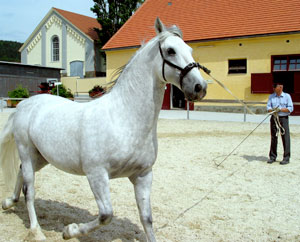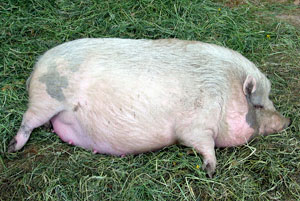LIGIST, AUSTRIA – As the gallant white stallion pranced around the outdoor ring snorting and sniffing and casting a menacing eye towards a nearby barn filled with mares, a young Austrian man turned to some friends and said: “I think the horse has had too much schilcher.”
Schilcher, the young man later told me, is the acidic-tasting wine grown in this beautiful southern region of Austria, known as Weststeiermark.
“Schilcher is Austria’s champagne,” said Marcus, who helped his father run a quaint chalet-style inn on the outskirts of Ligist, a pretty little village featuring a crumbling castle that was erected when the town was first settled 3,000 years ago. Ligist is not far from Piber, home of the world-famous Lipizzaner stud farm, and the place where I met Marcus and a few of his friends.
The hospitable young Austrians asked if I would like to take a short tour of the area with a promise of a schilcher taste testing once we reached his father’s hotel, the Enzianhof.
Austria has eight designated wine routes that cut through 18 areas where the grape is grown. Weststeiermark is located in the Styrian region of this amazingly beautiful country. The soil here is rich in gneiss and slate and produces a wine that Marcus described as being “freshly acidic.”

Above: The small town of Piber is home of the world-famous Lipizzaner stud farm.
The Styrian wine route is called Schilcherweinstrasse and starts in Ligist and winds through 20 kilometres of mountainous terrain bordered by farms, lush forests and idyllic vineyards before ending in Eibiswald in the south.
The Schilcherweinstrasse is easily accessed from Graz, the historic ancient capital of the region where political strongman Arnold Schwarzenegger was born. A super highway known as the A9 passes right in front of a Chrysler plant owned by
Canadian business tycoon Frank Stronach and connects Graz to the Styrian wine region.
As we began our tour, Marcus puffed out his chest and announced: “The reason Austria has so many wine regions is because we toast our good fortune (of living here) every day with our great wines.”
I was ready to drink to that but there was still a long way to go before reaching the Enzianhof and the schilcher.
The Schilcherweinstrasse takes visitors through enchanting villages like Stainz, Deutschlandsberg, Schwanberg, Eibiswald, Groß St. Florian and Wies. This is the smallest of Austria’s wine growing regions and most of the vineyards that occupy the 430 hectares devoted to wine here produce small yields.
Schilcher was first developed by local farmers as a drink to have on special occasions. The modern wine industry that evolved from those early beginnings now allows many others to enjoy the hidden sophistication of schilcher.
Not far into the drive you discover that wine making has not yet replaced farming as the area’s No. 1 industry. Just outside Stainz, Marcus pulled up in front of the Zagawirt restaurant and inn and pointed to the woods surrounding the Alpine-like property. In a clearing, we saw dozens of over sized pigs rolling in the muck.

Above: Ligist is a small farming community where the animals are obviously well fed.
“The pigs here are called waldschwein (wald means wood and schwein pig). They are half pig, half boar and they are very common here,” said Marcus.
The oversized pigs looked like there would explode at any minute.
“They are very good to eat and the Zagawirt has some very nice pork dishes,” said Marcus as we bid goodbye to that night’s entrée and headed in the direction of Rassach, where the Vinothek Schilcherstöck cooperative invites travelers to sample the cult wine known as schilcher.
It’s at the Vinothek Schilcherstöck where you learn much about Austria’s wine industry. Like:
- The 48,000 hectares devoted to wine in this land-challenged country are cultivated by 32,000 wine producers but only 6,500 bottle their own wines;
- Most of Austria’s wine regions are on the same latitude as Burgundy in France;
- Wine in Austria goes back to the dawn of civilization – grape pips have been unearthed in burial mounds dating back to 700 BC;
- Of the 280 million hectoliters of wine produced every year around the world, Austria accounts for less than one per cent of that total.
Every region of Austria is represented at the wine co-op, including, Vienna, the only national capital in the world where wine is grown. Records show the first vineyard began producing wines in Vienna as early as 1132.
“The Austrian word for Vienna is Wien and our word for wine is wein,” Marcus pointed out.
For two glorious hours Marcus guided us along winding roads, through market towns where produce was piled high on tables, before we finally reached his father’s cgarming hotel, which overlooks the rugged Styrian countryside.
A chilled glass of schilcher was waiting and Marcus ordered us to “enjoy.”
The wine appeared to be more rosé in look than champagne, with a colour varying from onion peel to salmon pink. No bubbles. The wine’s acidic introduction made me cringe.
“The wine inspires that reaction from most people,” said Marcus, who assured me that by the second glass, “it will be much smoother.”
Wine without the French attitude.
About the Author
Marc Atchison is a veteran journalist and a seasoned traveller with more than 20 years of travel writing experience. As the former Travel Editor of the Toronto Star, Canada's largest newspaper, and now Editor-in-Chief and Senior Writer for TraveLife magazine (Canada) and travelife.ca, Marc has been to over 100 countries in the world. Japan is one of his favorite destinations and he's been there on numerous occasions.